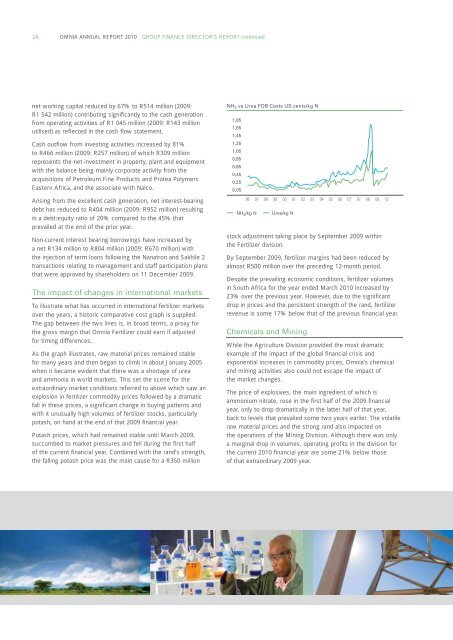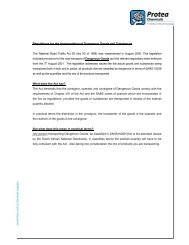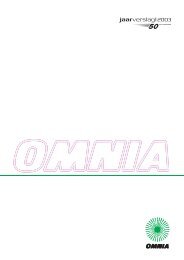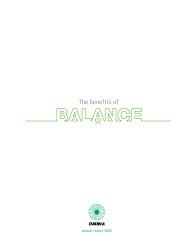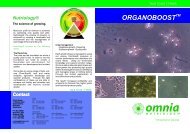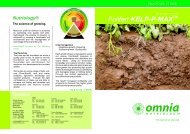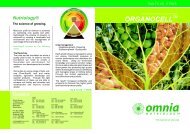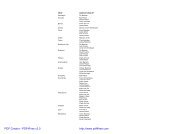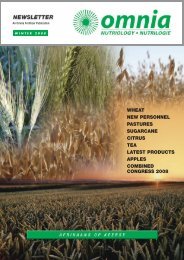omnia holdings annual report 2010 omnia holdings annu
omnia holdings annual report 2010 omnia holdings annu
omnia holdings annual report 2010 omnia holdings annu
You also want an ePaper? Increase the reach of your titles
YUMPU automatically turns print PDFs into web optimized ePapers that Google loves.
24 OMNIA ANNUAL REPORT <strong>2010</strong> GROUP FINANCE DIRECTOR’S REPORT continued<br />
net working capital reduced by 67% to R514 million (2009:<br />
R1 542 million) contributing significantly to the cash generation<br />
from operating activities of R1 045 million (2009: R143 million<br />
utilised) as reflected in the cash flow statement.<br />
Cash outflow from investing activities increased by 81%<br />
to R466 million (2009: R257 million) of which R309 million<br />
represents the net investment in property, plant and equipment<br />
with the balance being mainly corporate activity from the<br />
acquisitions of Petroleum Fine Products and Protea Polymers<br />
Eastern Africa, and the associate with Nalco.<br />
Arising from the excellent cash generation, net interest-bearing<br />
debt has reduced to R404 million (2009: R952 million) resulting<br />
in a debt:equity ratio of 20% compared to the 45% that<br />
prevailed at the end of the prior year.<br />
Non-current interest bearing borrowings have increased by<br />
a net R134 million to R804 million (2009: R670 million) with<br />
the injection of term loans following the Nanatron and Sakhile 2<br />
transactions relating to management and staff participation plans<br />
that were approved by shareholders on 11 December 2009.<br />
The impact of changes in international markets<br />
To illustrate what has occurred in international fertilizer markets<br />
over the years, a historic comparative cost graph is supplied.<br />
The gap between the two lines is, in broad terms, a proxy for<br />
the gross margin that Omnia Fertilizer could earn if adjusted<br />
for timing differences.<br />
As the graph illustrates, raw material prices remained stable<br />
for many years and then began to climb in about January 2005<br />
when it became evident that there was a shortage of urea<br />
and ammonia in world markets. This set the scene for the<br />
extraordinary market conditions referred to above which saw an<br />
explosion in fertilizer commodity prices followed by a dramatic<br />
fall in these prices, a significant change in buying patterns and<br />
with it unusually high volumes of fertilizer stocks, particularly<br />
potash, on hand at the end of that 2009 financial year.<br />
Potash prices, which had remained stable until March 2009,<br />
succumbed to market pressures and fell during the first half<br />
of the current financial year. Combined with the rand’s strength,<br />
the falling potash price was the main cause for a R350 million<br />
stock adjustment taking place by September 2009 within<br />
the Fertilizer division.<br />
By September 2009, fertilizer margins had been reduced by<br />
almost R500 million over the preceding 12-month period.<br />
Despite the prevailing economic conditions, fertilizer volumes<br />
in South Africa for the year ended March <strong>2010</strong> increased by<br />
23% over the previous year. However, due to the significant<br />
drop in prices and the persistent strength of the rand, fertilizer<br />
revenue is some 17% below that of the previous financial year.<br />
Chemicals and Mining<br />
While the Agriculture Division provided the most dramatic<br />
example of the impact of the global financial crisis and<br />
exponential increases in commodity prices, Omnia’s chemical<br />
and mining activities also could not escape the impact of<br />
the market changes.<br />
The price of explosives, the main ingredient of which is<br />
ammonium nitrate, rose in the first half of the 2009 financial<br />
year, only to drop dramatically in the latter half of that year,<br />
back to levels that prevailed some two years earlier. The volatile<br />
raw material prices and the strong rand also impacted on<br />
the operations of the Mining Division. Although there was only<br />
a marginal drop in volumes, operating profits in the division for<br />
the current <strong>2010</strong> financial year are some 21% below those<br />
of that extraordinary 2009 year.


